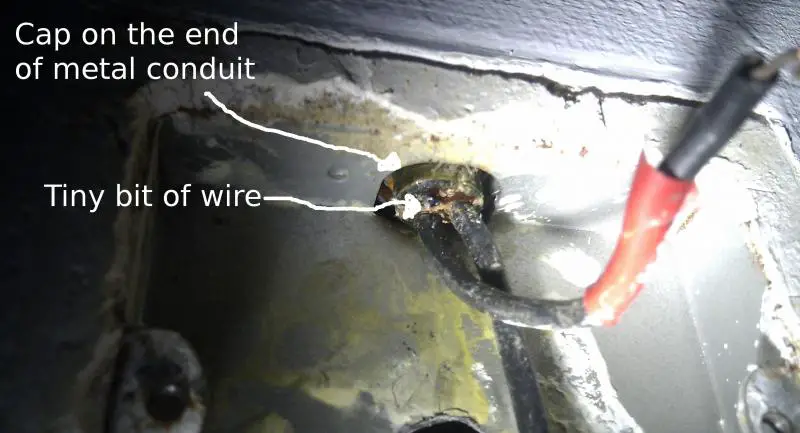Hi all,
I've got a bit of a problem and i'm hoping someone's got some ideas which doesn't involve re-chasing out the wall
Whilst replacing the dodgy light switch in my lounge i noticed that the core of one of the wires was just hanging in the insulation as the copper core had snapped (which would explain why it was dodgy)
I removed the insulation of the wire to see where it had snapped with the aim of doing a repair.
As you can see (from the picture below) there's a tiny bit (1-2mm) of the wire remaining this side of what looks like a cap. I know from around the rest of the flat that the lighting circuits are run through metal conduit which is earthed. The cap seems to be holding the wires in very tightly and there appears to be no way of removing it.
* Does anyone know what this cap is and how to remove it? Is there a set of connectors on the other side which i could use to replace it or put a repair in?
If i could remove it i think this would allow me to pull through maybe another ~3-4mm which would mean i could get a chocolate box on there and bridge it.
If that doesn't work I was also thinking about soldering another wire on to the tiny bit which is left and insulating it but as there's a lack of a real earth wire and i'm not behind an RCD this scares me a bit.
* Do any of you have any clever ideas on how to fix it or come across something like this before?
Thanks in advance (It's getting pretty dark in the flat )
)
D
I've got a bit of a problem and i'm hoping someone's got some ideas which doesn't involve re-chasing out the wall
Whilst replacing the dodgy light switch in my lounge i noticed that the core of one of the wires was just hanging in the insulation as the copper core had snapped (which would explain why it was dodgy)
I removed the insulation of the wire to see where it had snapped with the aim of doing a repair.
As you can see (from the picture below) there's a tiny bit (1-2mm) of the wire remaining this side of what looks like a cap. I know from around the rest of the flat that the lighting circuits are run through metal conduit which is earthed. The cap seems to be holding the wires in very tightly and there appears to be no way of removing it.
* Does anyone know what this cap is and how to remove it? Is there a set of connectors on the other side which i could use to replace it or put a repair in?
If i could remove it i think this would allow me to pull through maybe another ~3-4mm which would mean i could get a chocolate box on there and bridge it.
If that doesn't work I was also thinking about soldering another wire on to the tiny bit which is left and insulating it but as there's a lack of a real earth wire and i'm not behind an RCD this scares me a bit.
* Do any of you have any clever ideas on how to fix it or come across something like this before?
Thanks in advance (It's getting pretty dark in the flat
D


